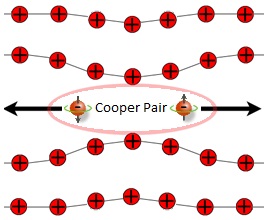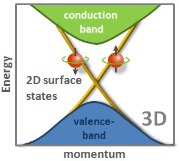
| Superconductors (S) and topological insulators (TI) are materials for which electron charge and spin show spectacular and surprising behavior. When these materials are brought into contact some striking effects are predicted -- including the formation of Majorana fermions. The main focus of this research is to use the local probing capabilities of specialized scanning microscopes to explore the physics of S/TI interfaces. |

|
Superconductivity occurs due to the formation of paired electrons known as Cooper Pairs. In classic s-wave materials, spin-opposite pairs form due to the interaction with lattice vibrations (phonons) that can give rise to an attractive force, despite the fact that negatively charged electrons are pushed apart by the Coulomb force. The composite two-electron objects acts like a boson instead of a fermion, allowing the formation of a charged superfluid which can conduct electricity with no resistance. Although Cooper pairs can leak through interfaces with other materials, the origin of the effect is a bulk phenomenon. |
| Topological insulators, on the other hand, embody a new state of quantum matter intimately connected to a surface or edge. Every material, and the vacuum itself, can be characterized by a topological invariant which takes an interger value. If the value changes across an interface with another material or (with the vacuum) a conducting state forms at the boundary or edge for which spin and momentum are locked together. This is very unusual for a conducting state. For example the conduction electrons in a typical metal can travel in any direction regardless of their spin. Three-dimensional TIs such as Bi2Se3 host such topologically-protected conducting states on their surfaces. When a superconductor is placed in contact with the surface, the interplay among the topology, single-particle electron spin, and the superconductor condensate symmetry leads to incredibly rich physics. The superconductivity induced into the TI is predicted to emulate p-wave pairing symmetry which allows the formation of Majorana fermion (MF) bound states. |

|
| The figure below shows data from a recent measurement near an S/TI interface using scanning tunneling microscopy [Dayton, et al., Phys. Rev. B 93, 220506(R), Published 20 June 2016]. The superconductors were nanometer-sized islands of PbBi evaporated onto the surface of topological insulator Bi2Se3. By measuring the local electronic structure we see evidence of both the superconductivity leaking into the topological insulator, and the TI surface states leaking onto the superconductor. |

|
| (a) Schematic illustration of the method. An STM tip is positioned both on top of the superconductor and on the TI substrate at various distances from the edge of the island. (b) STM image of the PbBi islands which were about 50 nm in both width and height. (c) Spectropy measurements of the local density of electronic states obtained at a temperature of 4.2 K with cryogenic STM. The distance from the island edge is indicated. As expected, superconductivity diminishes with distance as seen by the size of the gap feature indicated by the arrows. The top curve was aquired several microns away from the superconductor and exhibits only topological surface states forming a V-shaped Dirac cone. In contrast, the bottom curve shows the data acquired on the island fit to an ideal BCS superconducting gap feature. Surprisingly, it shows evidence of the topological states leaking onto the superconductor, as seen by the enhanced density of states at voltages outside of the energy gap. |